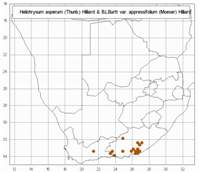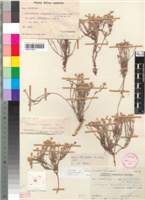Origin of name:
asper / -a / -um= rough
appressus = lying flat against; folium = leaf
Diagnostic characters:
Reduced needle-like leaves
Very small compact flower heads
Reddish bracts
Description:
Hard, lax, branches tend to be corymbosely arranged rather than stiffly divaricate, tangled, bushy shrublet mostly 15�400 mm tall, sometimes straggling, outer spreading branches then sending up numerous erect shoots, branches thinly grey-woolly, often glabrescent, rarely glandular-hispid, leafy. Leaves 2�6 x 0,5 mm (old primary leaves up to 20 x 1 mm), linear, acute to subacute, or obtuse, often apiculate, sessile, margins strongly revolute, both surfaces thinly white woolly-felted, often glabrescent, sometimes glandular-hispid as well. Heads homogamous, c. 4 x 2 mm, cylindric, solitary or 2�4, often more, together at the branch tips, closely surrounded by leaves. Involucral bracts in 5�6 series, outermost short, webbed with wool to surrounding leaves, inner subequal, equaling flowers, erect, tips semipellucid, subacute, often erose, pale brownish, often with a pink tinge, usually lacking the opaque white tips of var. albidulum, not radiating, soon caducous. Receptacle raised, slightly tuberculate. Flowers 7�13. Achenes not seen, ovaries with myxogenic duplex hairs. Pappus bristles many, equaling corolla, scabrid, bases with patent cilia not cohering.
Flowering November to March.
Distribution:
Dry gravelly or sandy places. Recorded from Willowmore degree square northeast and east to Cradock and Komgha.
Fynbos, Thicket, Grassland and Savanna Biomes.
Notes:
Var. appressifolium differs from the typical plant in its laxer habit, the branches tending to be corymbosely arranged rather than stiffly divaricate, and generally more heads crowded at the tips of the branchlets. The bracts are pale brownish, often with a pink tinge, usually lacking the opaque white tips of var. albidulum. The indumentum is woollier, less silky, than that of var. albidulum.
Five varieties are recognized. Not all specimens can be assigned to a variety. Putative hybrids have been reported.
la Heads mostly solitary or 2�4 at the branch tips, rarely more:
2a Tips of involucral bracts light golden-brown, often tinged red, semi-pellucid
(a) var. asperum
2b Tips of involucral bracts opaque white
(b) var. albidulum
1b Heads several at the branch tips:
3a Leaves 2�5 (�10) x 0,5 mm, glabrous
(d) var. glabrum
3b Leaves either variously woolly at least when young, or if glabrous, then leaves mostly 7�10 x 1�1,5 mm:
4a Leaves mostly 7�20 x 1�1,5 mm, woolly or glabrous; tips of involucral bracts white
(e) var. comosum
4b Leaves mostly 3�6 x 0,5�1 mm:
5a Leaves loosely woolly; involucral bracts semipellucid, buff-coloured, sometimes with a reddish tinge
(c) var. appressifolium
5b Leaves enveloped in tightly woven 'tissue-paper' indumentum (though this breaks down to wool with age); tips of involucral bracts opaque white, often reddish above the stereome
(b) var. albidulum
Taxonomy:
Literature:
Helichrysum asperum (Thunb.) Hilliard & Burtt var. appressifolium (Moeser) Hilliard & Burtt in Notes R. Bot. Gdn Edinb. 34: 79 (1975); Hilliard, Compositae in Natal 208 (1977).
Type:
Eastern Cape, Albany distr., near Grahamstown, Botha's Hill, 660 m, 21 xii 1894, Schlechter 6091 (BM; K; PRE; S, iso.).
Synonym(s):
H. ericifolium Less. var. appressifolium Moeser in Bot. Jb. 48: 339 (1913).
Vouchers:
Burtt Davy 12144 (PRE); Esterhuysen 13634 (BOL: PRE); Fourcade 2949 (PRE): Hilliard & Burtt 10578 (E; K; NU; S).


